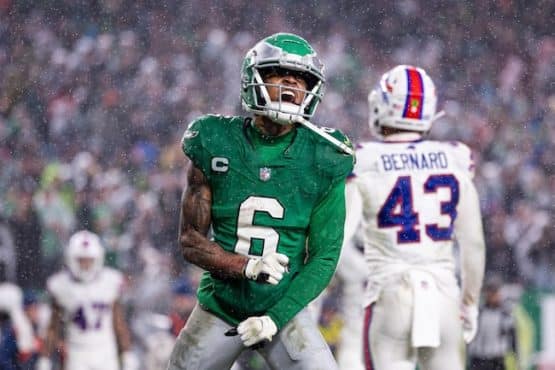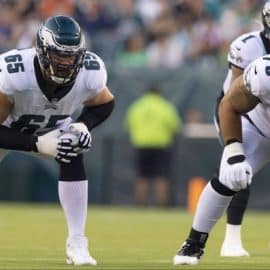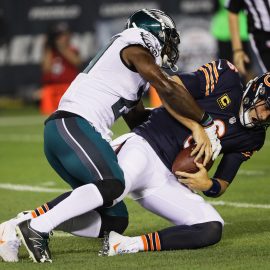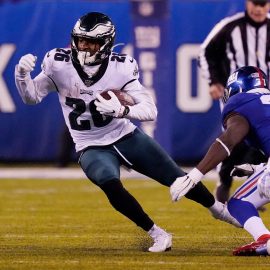I need to first update some information on what players get paid for attending Training Camp… Under the new CBA agreement, if you are selected to attend TC, the weekly “per diem” fee has increased to $1,600… that’s a big jump above the $900 number I reported earlier…and of course, all meals, board, and medical care are included in the deal.
But the extra dough does not mitigate the fact that Training Camp is still a hellacious experience…
Don’t believe me— take it from a veteran NFL player who’s been there numerous times…
Nate Jackson was a tight end and wide receiver with the Denver Broncos from 2003-08. Recently he wrote about his TC experiences for the New York Times… He has allowed Eagles fans to share in the reality…
Your body says No, but your brain says Yes.
Yes, you will get out of bed. Yes, you will try to eat breakfast. And Yes, you will put on your pads and run out on that field. Despite the pain, the doubt, and the fear, you will say Yes. You always say Yes.
Training camp is hell. Some players adapt to hell well, some burn up quickly. But there is no way around the psychological and physical warfare that players will endure this month.
In a strictly physical analysis, training camp brutalizes the body. The NFL is home to the strongest, most explosive athletes on the planet. Being hit over and over again by these men is a painful ordeal, not so much as it’s happening, but after the fact: after practice, late at night, early in the morning. Morning is the worst.
About three or four days into training camp is when the soreness starts to peak, and it sticks around for about a week and a half until your body starts to desensitize itself to misery. During my six seasons with the Denver Broncos, there were days when getting out of bed was so difficult I was sure there was no way I could practice. Of course I was wrong. I found a way to get it done. Football players learn how to push down the pain and make a play. But it hurts later. It hurts a lot.
Compounding the physical pain is the strange dichotomy between players and coaches. Coaches expect mathematic perfection from their players, so most often, whatever a player does is not quite right. There is always something to improve, even when you get the job done. As my friend Stefan Fatsis eloquently describes it in his book A Few Seconds of Panic, about the summer he spent on the field with me and my Denver teammates (as a kicker), different coaches communicate in different ways. But in the NFL, the militaristic approach usually dominates: veiny-foreheaded doppelgangers berating players daily.
The longer you’re around, the more the cackle becomes background noise, which you learn to accept as an industry standard. But it’s unproductive, because the aim begins to be, “Don’t make a mistake, don’t get yelled at.” That’s an awful way to play football, especially when the dudes doing the yelling are or were inferior athletes to you.
The verbal haranguing isn’t exclusive to the field. In meetings every day and night, it continues. The decibel level decreases, but it’s no less biting. Every play of every practice is watched on film by the whole team that same day. Morning practice is watched in the afternoon before the afternoon practice, and the afternoon practice is watched at night before going home. Practices are watched on huge screens with high quality projectors. When a player makes a mistake, it is pointed out and discussed.
Nothing slips through the cracks. Depending on the severity of the mistake, and the frequency of mistakes being made by the player, the reaction from the coaches will vary, but the feeling for the player is always horrible. Being called out in meetings and having everyone in the room watching you fail in slow motion — often with a laser pointer on your two-dimensional body — is demoralizing, and only intensifies the pain. This scrutiny is well intentioned, but often falls flat from overkill, the message trampled by the messenger.
Teams will go through their training-camp schedule for about eight days before a day off. Eight straight days is bad enough, but the length of each day makes it feel much longer. Each day feels like three days. Players arrive at the facility at roughly 7:30 a.m. The first practice is at 8:30 and lasts until around 11. After that comes lunch and a bit of down time, when players relax however they can: napping, video games, reading, crying. A special-teams meeting at around 1:30 p.m. is followed by offense/defense meetings, then back on the field around 4 for a slightly shorter practice than in the morning. After practice is dinner, then meetings from 7 p.m. until 10 p.m.
The meetings drag on more than one would imagine. NFL players spend typically twice as much time in meeting rooms as they do on the field. The attention to detail and robotic application of minute coaching points become an obsession, so there’s always something to fix. This drains the brain. It’s not uncommon to see a rookie make mistake after mistake as he mopes around the field on one day or another, simply because his brain is filled to the brim with detailed coaching points. The players who end up making the team and having a sustained career in the N.F.L. are the ones who can process these details and apply them quickly. It’s one thing to understand what you’re supposed to do, but to actually do it, at 100 miles an hour against the best in the world, is another thing entirely.
Adding to the general feelings of blah and barf are cuts that must be made as August progresses. Realistically, of the 80 guys on each roster, 15 are already cut. Coaches have a pretty good idea of what the final roster will look like. There’s a little bit of wiggle room in the middle of the depth chart. At every position, there are usually two guys competing for one spot. This is usually where I found myself, fighting for my professional life on a daily basis, battling with another good football player who was often my friend. I learned how to win that daily battle, but it never came easy, and someone was always left in its wake.
But this is in the middle of the depth chart, meaning that if a team is carrying 10 receivers in camp, receivers Nos. 5 and 6 are battling for a job. Nos. 7 through 10 are camp bodies, there to bolster the numbers, to take punishment, to give veterans an occasional rest, to serve as verbal punching bags for position coaches trying to make a point. This happens at every position, even quarterback. Players see this happening to them, and there is nothing they can do about it. At the bottom of the depth chart, guys get very few quality “reps” — repetitions, turns to play in practice. Coaches often encourage these players, saying things like, “Don’t count your reps, make your reps count!” But reality sets in. For many, this will be the last football they will ever play.
Yes, there is much to worry about this month for players on NFL teams. For every superstar, there are 10 blue-collar players who fear their job security is in danger. This fear makes them anxious and paranoid. If you know someone in the N.F.L., leave him alone this month. If he survives, he will be better for the experience. Just wait until September to ask him about it.
—Thank you, Nate Jackson. (I wonder if we are related?)
Add The Sports Daily to your Google News Feed!







